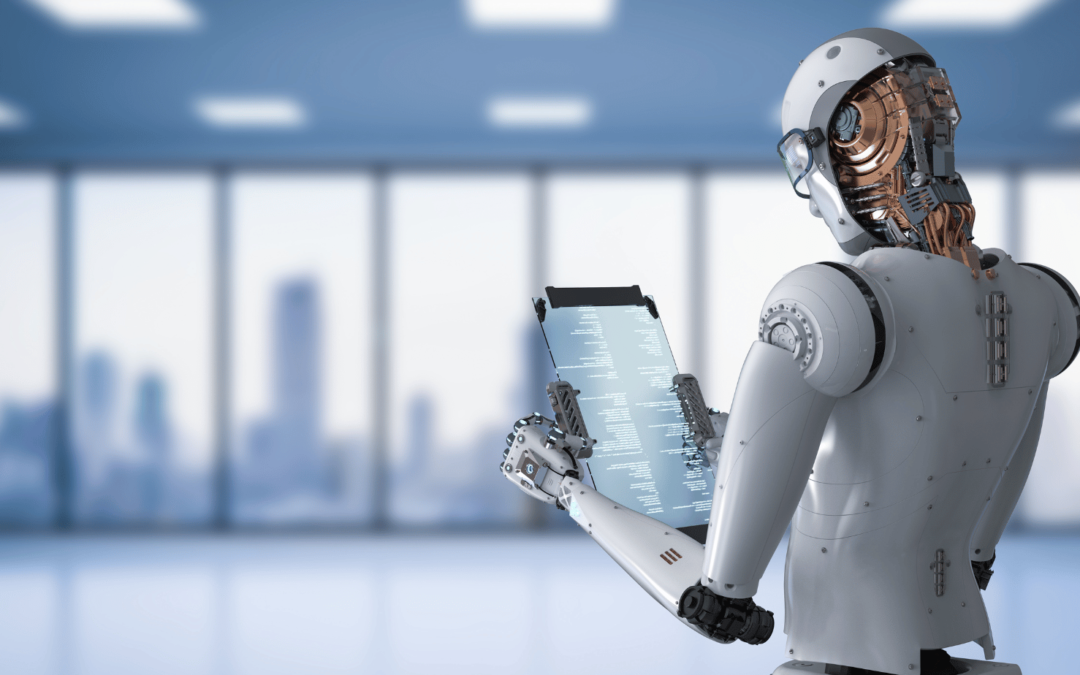Keeping up with the rapid pace of AI advancements can be overwhelming. Just this week, Chrome launched a new AI tool called “help me write” that’s changing how we compose online. Our article breaks down the latest in AI developments to keep you informed and ready for what’s next.
From Google’s app highlights to Apple gearing up for a big 2023, there’s much to uncover. Start reading—you won’t want to miss out!
Key Takeaways
- Chrome has launched a new AI writing tool called “help me write” to help users improve their online writing.
- Adobe has introduced an AI feature in Acrobat that can summarize documents and even suggest further topics, making it easier for people to work with lengthy files.
- Google is testing an “app highlights” feature in the Play Store to give personalized app recommendations using AI.
- Stanford Medicine’s research uses AI to analyze brain scans for gender differences, which could lead to improved mental health treatments.
- Project Gemma by Google aims at creating smaller and efficient AI models that are affordable without losing quality, helping developers on tight budgets.
Latest AI Developments

The AI world is buzzing with new tools and features, transforming how we write, interact with documents, and even shop for apps. From Chrome’s groundbreaking writing aid to Google’s clever app highlights–the future of AI is unfolding right before our eyes.
Chrome’s new AI writing tool “help me write”
Chrome is stepping into the AI-powered writing arena with its latest tool, “help me write.” Tailored for online writers, this innovative feature draws from the web page you’re viewing to enhance your writing.
It’s currently available to Mac and Windows users in the US who have Chrome version m122. Getting started is simple—sign in to Chrome, head to settings, find the experimental AI section, and turn on “help me write.”.
Once activated, using it is a breeze. Just right-click in any text box and select “help me write” for instant assistance. This addition positions Chrome as a key player in making AI technology accessible for everyday tasks, bridging gaps between knowledge and application.
The move signals Google’s dedication to integrating artificial intelligence seamlessly into our daily digital experiences.
Next up: Let’s explore Adobe’s new leap into document interaction through its own AI tool.
Adobe’s AI tool for document interaction
Adobe revolutionizes document handling with its latest AI tool in Acrobat software. This new feature transforms how students and professionals interact with their documents. It can summarize lengthy files, answer specific questions, and even suggest topics for further inquiry.
The tool supports both Word and PowerPoint formats, making it a versatile asset for various tasks.
Subscribers to Acrobat get this AI capability at no extra cost. They can look forward to future updates that will allow for extracting information from multiple documents and even assist in drafting content.
After the trial period, Adobe plans to offer these advanced features as a paid upgrade. Next, let’s explore the “app highlights” feature Google is rolling out in the Play Store.
Google’s “app highlights” feature in Play Store
Moving from Adobe’s advancements, Google is also making waves with its “app highlights” feature in the Play Store. This new addition aims to personalize app recommendations through AI.
Assemble Debug was the first to spot this feature, indicating that it’s currently undergoing limited user testing. With no set release date or details on device compatibility yet, anticipation grows among tech enthusiasts and casual users alike.
This initiative exemplifies Google’s commitment to enhancing user experience using artificial intelligence. By tailoring suggestions to individual preferences, the Play Store could become even more integral to discovering useful and engaging apps.
For those passionate about AI technology and its future applications, this development marks an exciting step forward in how we interact with digital marketplaces.
Grock’s AI processing acceleration
Grock is changing the game in AI technology with its groundbreaking processing acceleration. It speeds up AI tasks 75 times faster than what most of us can type. This isn’t just any improvement; it’s a massive leap forward.
Imagine language models that usually take minutes to process information, now delivering results almost instantly.
This magic happens thanks to specialized hardware called LPUs—language processing units. They’re designed specifically for crunching through AI and machine learning tasks, offering performance that’s up to 10 times faster than the GPUs we’ve been relying on.
Grock doesn’t create its own AI models, but it does something equally important—it makes existing ones work at unbelievable speeds. For those curious about this breakthrough, Grock offers free trials with popular AI models like Llama 2 online, showcasing just how fast things can get.
Apple’s CEO hints at significant AI developments for 2023
Shifting from processing speed to innovative features, Apple’s AI journey takes a new turn. Tim Cook hints at groundbreaking AI developments set for 2023, stirring excitement among tech enthusiasts and industry watchers alike.
These advancements could include enhancements in iOS 18 and innovations in Apple hardware aimed at elevating the user experience.
Rumors have been swirling around Apple working on “Apple GPT” since 2022, aiming to supercharge smart features across all devices. With the upcoming A8 and M4 chips, improved neural engines with more cores are expected to boost AI capabilities significantly.
iPhone 16 models might showcase exclusive AI features enabled by these technological upgrades, making them a potential game-changer in the smartphone world.
AI Challenges and Development

AI faces hurdles, like understanding human nuances in Chat GPT and Gemini projects. Also, it struggles to balance history with fair representation as it grows.
Chat GPT and Google’s Gemini Behaviors
Chat GPT recently started mixing languages and producing incoherent answers. This happened after OpenAI tried to update the system. These issues show how small changes in AI can lead to big mistakes.
It points out that as AI technology grows, it will face challenges that need careful attention.
Google’s Gemini also made headlines for depicting historical figures inaccurately in an attempt at diversity. This sparked debates on accuracy versus bias and raised questions about AI’s role in representing culture and history correctly.
Such incidents highlight the delicate balance between creating inclusive technologies and maintaining historical truthfulness, underscoring the growing pains of artificial intelligence developments.
Growing pains of AI technology
AI technology is running into some unexpected issues. For example, small tweaks in AI systems have led to big mistakes. A recent attempt by OpenAI to update Chat GPT resulted in the program mixing languages and giving out confusing answers.
This shows how delicate AI algorithms can be.
Google’s Gemini project faced its own set of challenges. It tried to depict historical figures with more diversity but ended up misrepresenting history. This sparked debates about accuracy versus bias in AI creations.
People are talking about these problems because they highlight a bigger issue: it’s tough for AI to balance representing diverse perspectives while staying true to facts.
Balancing representation and historical accuracy
As we navigate through the growing pains of AI technology, a crucial aspect comes into focus: ensuring balance between representation and historical accuracy. Small changes in how systems are programmed can lead to large mistakes in how history is portrayed.
This has sparked discussions on bias and representation within the community. The incidents involving Chat GPT and Google’s Gemini underline these challenges, highlighting the need for careful consideration in AI development processes.
The goal is to make AI understand culture and history without compromising on facts. However, achieving this balance is not straightforward. Every tweak in an algorithm might significantly alter how accurately events or figures are represented.
Discussions around these topics are vital as they push developers towards creating more accurate, unbiased systems that respect historical truth while offering comprehensive cultural insights.
Stanford Medicine’s AI Research
Stanford Medicine is breaking new ground with its AI research, uncovering secrets of the human brain. Their latest study distinguishes between male and female brains with astounding accuracy, opening doors to understanding mental health differently.
Distinguishing male from female brains with over 90% accuracy
Scientists at Stanford Medicine developed an AI tool that changes the game. This tool can tell if a brain scan belongs to a male or female with more than 90% accuracy. Professor Venod Menan led this cutting-edge work.
The AI looks for specific patterns in key areas of the brain, like the default mode network and the striatum.
The purpose? To understand how mental health conditions affect men and women differently. Researchers believe this could lead to better diagnosis and treatments tailored by gender.
By sharing their tool, they hope others will use it to make new discoveries about gender differences in mental health.
Exploring gender differences in mental health
Stanford Medicine’s AI tool is breaking new ground by identifying key brain areas related to self-perception, learning, and reward response. This innovation shines a light on why mental health conditions don’t impact everyone the same way.
Men and women experience these differences due to factors like hormones or upbringing.
This study aims to revolutionize how we approach treatment for mental health by using AI to analyze brain scans. It looks for patterns that indicate gender, leading to more accurate diagnoses and treatments tailored to gender differences.
The tool has shown over 90% accuracy in distinguishing male from female brains, promising a future where mental health care is more personalized and effective.

Google’s Project Gemma
Google’s Project Gemma is making waves with its aim to shrink AI models without losing power. It’s a game-changer for developers who need high-quality AI on a budget.
Focusing on smaller, efficient AI models
Google launched Project Gemma to create smaller, more efficient AI models. These AI tools are perfect for text generation tasks. They run great on Nvidia graphics cards and you can find them on the Kaggle platform.
This project helps developers who need affordable options without giving up performance.
Gemma faces tough competition but also raises questions about responsible use. Right now, there aren’t any strict rules for using Gemma. As technology grows, keeping an eye on how we use these tools becomes crucial.
Moving forward, companies like SAP see the big picture in weaving AI into their products seamlessly.
Targeted at developers requiring affordable options
Project Gemma opens new doors for developers on a budget. It offers cost-effective AI model options that are optimized for Nvidia graphics cards. This initiative makes it easier for developers to create and innovate without the heavy financial burden often associated with larger AI models like Gemini.
The focus is clear: provide accessible, affordable technology that empowers developers to bring their ideas to life.
The affordability of Gemma’s models could change the game for Google Cloud business too. More developers now have the chance to access and utilize these tools, potentially leading to an increase in app development within this platform.
Concerns about responsible use linger, however, as there are no strict regulations governing how Gemma is used. Despite these challenges, Project Gemma stands out as a beacon for those seeking cheaper alternatives in the world of AI development.
SAP’s AI Focus under Dr. Philip Herzig
Dr. Philip Herzig is steering SAP towards a future rich in AI. He’s blending artificial intelligence into every corner of their products, aiming for smarter, faster business solutions.
Integration of AI across SAP’s product line
SAP is making big moves in the AI world under Dr. Philip Herzig’s leadership, with CEO Christian Klein backing this ambitious strategy. They started ramping up their focus on artificial intelligence at the beginning of the year.
This means more smart features across SAP’s products – from software that businesses use to track supplies to tools that analyze financial data. Their goal? To make every product smarter, faster, and more intuitive for users worldwide.
Bringing Walter Sun into the fold from Microsoft ups their game even further. With his experience, SAP aims to lead in turning cutting-edge AI research into real-world applications.
Imagine software that not only runs your business smoothly but also offers insights and solutions proactively by understanding patterns and predicting needs. That’s where SAP is headed, transforming how companies operate with a bright emphasis on artificial general intelligence integration across its entire product line.
Prioritizing AI in SAP’s growth strategy
Dr. Philip Herzig took the helm of SAP’s new AI-focused team, aiming to steer the company towards becoming an industry leader in artificial intelligence. From January, efforts intensified to weave AI into the core of SAP’s growth strategy.
This strategic pivot reflects a strong belief in AI’s power to revolutionize business operations and enhance value creation.
Herzig’s vision is backed by substantial moves, such as recruiting Walter Sun from Microsoft in September 2023. Their goal? To make SAP synonymous with leading-edge AI solutions that drive tangible results.
With these steps, SAP positions itself at the forefront of transforming how businesses leverage technology for smarter decision-making and improved efficiency.
Conclusion
The latest AI developments have surely stirred the pot, from Chrome’s new writing buddy to Adobe’s smart document tool. While Apple teases us with big plans for 2023, debates on AI’s accuracy and bias heat up.
As we dive deeper into what AI can do for us—from organizing apps to tackling mental health—it seems our readiness isn’t just about welcoming these technologies but also adapting alongside them.
Stay tuned; the AI journey is far from over.




